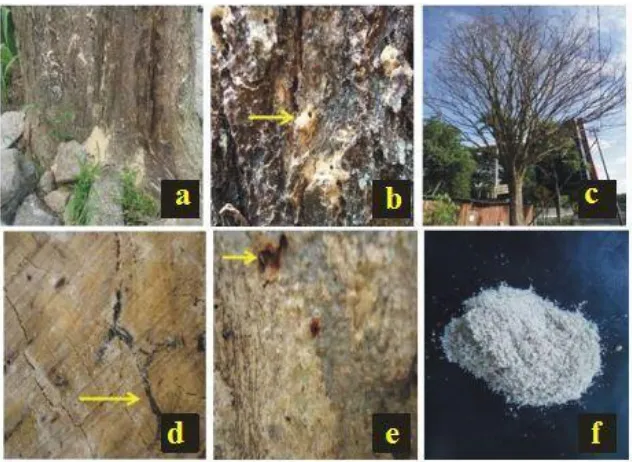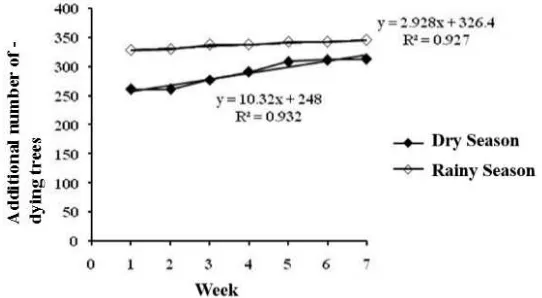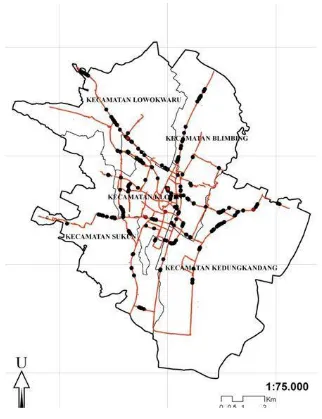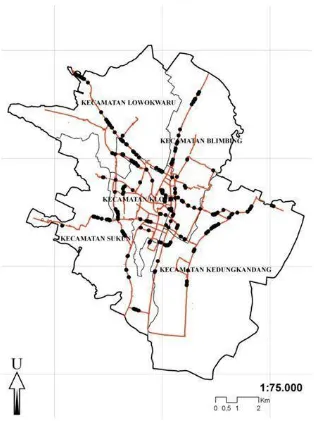http://dx.doi.org/10.17503/Agrivita-2014-36-2-p189-200
FIRST RECORD OF AMBROSIA BEETLE (
Euplatypus paralellus
Fabricius)
INFESTATION ON SONOKEMBANG (
Pterocarpus indicus
Willd.)
FROM MALANG INDONESIA
Hagus Tarno*), Hasan Suprapto and Toto Himawan
Plant Protection Department, Faculty of Agriculture, University of Brawijaya Jl.Veteran, Malang 65145, East Java, Indonesia
*)
Corresponding author Phone: +62-341-575843 Email: [email protected]
Received: May 6, 2014 / Accepted: July 21, 2014
ABSTRACT
Sonokembang (Pterocarpus indicus Willd.) is native of Asia trees, and commonly planted in 2012. Seven variables was also investigated such as characteristic of tree`s damage, distribution of holes based on sunlight exposure, vertical position of stem, and stem diameter, morphological characteristic of beetle, the intensity of dying trees, and distribution of dying trees. Results showed that there were unique damaging characteristic such as dying and then fallen leaves, holes on the stem and branches, and frass production. Euplatypus parallelus Fabricius was identified as a causal agent of dying sonokembang. There were some indications shown such as beetles preferred to attack stem side with much sunlight exposure, upper stem and medium or bigger size of stem diameter. From 3,206 trees on 76 roads, 69.7% were found dying trees. In dry and rainy season, the intensity of dying trees increased from 8.14 to 9.76% and from 10.26 to 10.79%, respectively.
Keywords: Euplatypus paralellus, frass, dying trees, number of holes, sonokembang
INTRODUCTION
Pterocarpus indicus Willd. is described as native of Asia (Anonymous, 2005), it has the (Indonesia). Sonokembang is commonly planted in large numbers as ornamental or shade trees along roads, in parks and residential areas in the tropics (Furtado, 1935). This tree is beauty and fast growing, evergreen, has an attractive canopy shape, and has a typically synchronized short flowering period (Furtado, 1935; Joker, 2002). This tree is of social and ecological value especially in urbanized areas (Bumrungsri et al., 2008).
Wilt disease on sonokembang was first reported in Malacca in 1870 (Sanderson et al., 1996). The disease was recorded in Singapore in 1914 and many trees had either been killed by the disease, or had been removed to prevent its spread in 1919 (Sanderson et al., 1996). In addition, over 800 trees were removed as a consequence of the disease between 1980 and 1992 (Sanderson et al., 1996).
on Japanese Oaks (Esaki et al., 2004). Similar case was occurred in South Korea, Moon et al. (2008) reported ambrosia beetle, P. koryoensis (Murayama) (Coleoptera: Platypodidae) as an ambrosia fungi vector caused dying oak trees in South Korea. In the tropical area, there were some examples such as in an urban area of Campinas City, Brazil, Platypus parallelus and P. sulcatus were found attacking 16.2% of the trees, mainly in the Caesalpinaceae family (96% of the records (Queiroz and Garcia, 2007). In Singapore, P. parallelus was ambrosia beetle which collaborated with Fusarium oxysporum, caused dying trees of sonokembang in urban area (Sanderson et al., 1996; Sanderson et al., 1997b).
Based on the important value of sonokembang and there was no report related to dying sonokembang trees in Indonesia, research was aimed to identify damage intensity of dying trees on sonokembang and to clarify the causal agent of dying trees. Characteristic of tree`s damage, distribution of holes based on sunlight exposure, distribution of holes based on vertical position of stem, distribution of holes based on stem diameter, morphological characteristic of beetle, the intensity of dying trees, and distribution of dying trees was also investigated on sonokembang in Malang, Indonesia.
MATERIALS AND METHODS
Research was conducted in five sub districts of Malang City (Klojen, Sukun, Lowokwaru, Kedung Kandang and Blimbing), Laboratory of Entomology, and Laboratory of Geographic Information System, Faculty of Agriculture, University of Brawijaya from May to December 2012. There were three groups of activities in this research. First one, we counted and calculated dying trees from all of sonokembang trees distributed among seventy six roads located in five sub districts of Malang. This activity was aimed to identify the intensity and the distribution of dying trees. Second one, we observed eighteen trees which located in Veteran Street (Lowokwaru sub district). Eighteen trees were chosen randomly, then classified into three categories of stem`s diameter, vertical position of stem and sunlight exposures. Second activity was aimed to describe characteristic of sonokembang tree`s damage, distribution of holes based on sunlight
exposure, vertical position of stems and stem`s diameters. Last one, we collected samples of ambrosia beetle from five dying trees at once to check the morphological characters for species identification of ambrosia beetle.
Characteristic of Sonokembang Tree`s Damage
All of sonokembang trees on 76 roads were observed in a week regularly for seven weeks. Characteristic of attacked and damaged trees were described by using symptom and sign on stems and leaves. All characters were clearly described and documented. Picture was also used to described symptom and sign of tree`s damages.
The Intensity of Dying Trees
Numbers of healthy, attacked and dying trees were recorded to estimate intensity of dying trees. Each healthy, attacked and dying tree were marked and recorded. All of sonokembang trees on 76 roads were observed in a week regularly for seven weeks and then data was classified into two groups i.e.: dry and rainy season. By MS-excel 2010, chart was used to describe the intensity of dying trees for each season.
Distribution of Dying Trees
vertical position of stems. Eighteen trees were divided into three categories based on size of stem`s diameter and vertical position of stems. First categories of stem`s diameters was small size (19.0-35.5 cm), medium size (36.0-45.5 cm) and large size (46.0-59.0 cm).
Second categories based on vertical position of stems included lower part (5-26 cm), middle part (57-78 cm), and upper part (109-130 cm) from ground. Finally, we compared between two groups based on sunlight exposure for eighteen tree`s samples. Transparent plastics and permanent inks were used as tool to calculate the number of hole. Total number of holes were calculated for each stem`s side and compared each other. By using MS-excel 2010, T-test was used to compare data of number of holes between two aspects.
Distribution of Holes Based on Vertical Position of Stems
Eighteen trees were used as samples and divided into three parts for each tree. Distribution of holes on stem vertically was described based on three parts such as 5-26 cm (lower part), 57-78 cm (middle part) and 109-130 cm (upper part) from basement. Transparent plastics and permanent inks were used as tool to calculate
the number of hole for each part. Transparent plastic was attached on bark in three heights (parts) and counted by making mark on it. Total number of holes was calculated for each (height) part and compared each other by using analysis of variance (anova) and continued by post hoc (Tukey). SPSS 17 was used as statistical software.
Distribution of Holes Based on Stem`s Diameter
Eighteen trees were divided into three groups based on the size of stem`s diameter, and six trees for each group. Stem diameter were divided on three categories i.e. small size (19.0-35.5 cm), medium size (36.0-45.5 cm) and large size (46.0-59.0 cm). Transparent plastics and permanent inks were used to count the number of hole. Total number of holes was calculated for each stem`s diameter and compared each other by using analysis of variance (anova) and continued by post hoc (Tukey). SPSS 17 was used as statistical software.
http://dx.doi.org/10.17503/Agrivita-2014-36-2-p189-200 Morphological Characteristic of Beetle on
Sonokembang
Beetle`s samples were collected from five attacked trees at once to clarify species of beetle. Beetle`s samples were handpicked and then fixed by 70% alcohol. Clarification of beetle`s samples was conducted by using Wood (1993) and Atkinson (2011) for species level. Identification of samples and analysis of data were conducted in the laboratory of entomology, Faculty of Agriculture, University of Brawijaya, Malang.
In addition, we also collected data of temperature from Station of Climatology, Meteorology and Geo-physic (BMKG) Karang Ploso, in Malang. Temperature was used only from May to June and from October to November 2012.
RESULTS AND DISCUSSION
Characteristic of Sonokembang Tree`s Damage
Based on our observation, symptom on attacked trees by ambrosia beetle was described as fallen leaves. Sign was shown by some holes on tree’s stems and branches, frass around holes and on ground. In addition, During observation, powdery frass dominated (Figure 2f). Diameter average of holes was 1.9 ± 0.2 mm. Gallery pattern inside of stems was clearly shown with a black color (Figure 2d).
There was evident that dying trees were caused by tiny beetle, and commonly called as ambrosia beetle. On all of dying trees were found some indicators related to ambrosia beetle activities such as frass and the beetle itself. Sanderson et al. (1996) mentioned that in Singapore, during 10 months periods there were 87% of 147 wilting P. indicus trees had been attacked by ambrosia beetle (Platypus spp.) and struck by lightning. In urban area of Campinas Japanese ambrosia beetle, Platypus quercivorus (Murayama), and same types were found in this research i.e.: fibrous and powdery frass. Fibrous frass was produced by adult beetles both male quercivorus caused serious damage on Japanese Oak forest, and they make gallery inside wood laterally and vertically (Kinuura and Kobayashi, 2006). Platypus koryoensis was identified as ambrosia beetle in South Korea and they produce the same symptoms and signs such as Japanese ambrosia beetle (Moon et al., 2008). In United State, there were seven species of Platypus and four species found in Florida (Atkinson, 2011). All species in Florida caused dying trees and give economic impact in United State (Atkinson, 2011). In Brazil, (Queiroz and Garcia, 2007).
1996; Sanderson et al., 1997a; Sanderson et al., 1997b).
Distribution of holes based on sunlight exposure. Based on T-test, there was no different between number of holes on surface of stems under much sunlight exposure and less sunlight exposure based on vertical position of stems. Few number of samples have to be responsible factor to make no different result. It was clearly described when we compared all of samples of trees as cumulative samples (Table
1), there was difference between much sunlight exposure and less sunlight exposure. It means that commonly ambrosia beetles preferred to attack stem sides with much sunlight exposure. In Japan, adults of P. quercivorus have positive phototaxis and prefer to healthy trees (Igeta et al., 2003). Positive phototaxis behavior of ambrosia beetle can guide beetle to choose stem sides of trees with much exposure of sunlight.
Figure 2. Sign and symptoms of attacked and dying trees, i.e.: Frass on basement of tree (a), holes on stem (b), fallen leaves (c), gallery pattern inside tree’s stem and branches (d), red color around newly hole (e), and powdery frass (f)
Table 1. Number of holes based on sunlight exposure based on categories
Categories Number of Holes (Average±SE)
Much Sunlight Exposure Less Sunlight Exposure
Position of Stem:
Upper (109-130 cm) 24,556 ± 3,785 ns 20,611 ± 3,468 ns Middle (57-78 cm) 22,111 ± 3,499 ns 18,500 ± 2,942 ns Lower (5-26 cm) 14,444 ± 2,269 ns 13,778 ± 1,837 ns Stem Diameter:
Small (19.0-35.5 cm) 16,278 ± 3,289* 10,722 ± 2,448* Medium (36.0-45.5 cm) 22.944 ± 4,080ns 24.000 ± 3,478ns Large (46.0-59.0 cm) 21,889 ± 2,453ns 18,167 ± 1,481ns Cumulative (All tree`s samples) 20.339 ± 1.935* 17.736 ± 1.651*
Distribution of Holes Based on Vertical Position of Stems
In Table 2, number of holes on three different position of stem vertically showed that there were differences between upper stem and others. It means that beetle preferred to attack upper stem (up to 109 cm from above ground). This result, supported by Igeta et al. (2004) that adults of P. quercivorus preferred on trees less than 250 cm from ground.
Table 2. Number of holes based on vertical position of stems
Stem position vertically Number of Holes (average ± S.E.)* diameter showed that there were differences between three sizes of stem diameter (Table 3). Medium diameter of stem (36.0-45.5 cm) was significantly different with others. Average of number of holes on medium diameter of stem was 23.472 ± 2.644. It means that beetle preferred to attack medium and bigger size of stem diameter. Stem with bigger diameter tend to provide the bigger volume of sapwood. Bigger volume of sapwood will provide enough area for ambrosia beetle. It’s related to the case of rearing of Japanese ambrosia beetle, where ambrosia beetle preferred to bigger size of oak logs (Kitajima and Goto, 2004; Tarno et al., 2011). In
the forest, tree size can be an important factor for tree selection by P. quercivorus (Yamasaki and Sakimoto, 2009) and the larger diameter trees having the highest incidence of P. subgranosus attack (Elliot et al., 1987).
Morphological Characteristic of Beetle on Sonokembang
Based on morphological characteristic of beetles, beetle`s samples were collected from all sides in Malang city can be classified into Platypodinae with clubbed antenna, round and convex eyes, and brown body (Figure 5a). Boror and Dwight (1992) mentioned that beetles commonly with brown color and 2-8 mm in length. Their pregule sclerite was narrow and similar to their pregule (Figure 5a). This beetle can be classified into Platypodini with distance on posterior of prothorax extremely tend to pleural area and mesoepisternum clumb. Protibia on male was protected by four or more hairs (Figure 5c) and there was suture in tip with or without tubercles and spines (Figure 5b). They had body’s length ca. 4 mm (Figure 3a-b and 4a-d). Pronotum without conspicuous pores in either sex and based on elytra of beetle`s samples, declifity of male elytra was same to the declifity of Euplatypus parallelus. Atkinson (2011) explained that on male elytra of P. parallelus (synonim of E. parallelus), male elytral striae deeply impressed, subequal in width to interstriae at base of distribution inthe Afrotropical region. Euplatypus parallelus are extremely polyphagous and commonly attracted to light (Atkinson, 2011). In Asia, especially Malaysia, Singapore, Thailand and India, there were several reports related to Euplatypus (Sanderson et al., 1997a; Sanderson et al., 1997b; Bumrungsri et al., 2008 and Maruthadurai et al., 2013). Euplatypus parallelus was also found in USA such as Florida (Atkinson, 2011), Texas and Oklahoma (Atkinson and Riley, 2013), In South America, Brazil there were some reports about Euplatypus (Queiroz and Garcia, 2007; Zanuncio et al., 2002).
Diameter of stem Number of holes (average ± S.E.)*
Figure 3. Morphological characteristics of beetle in whole body, Female (a) and Male (b)
Figure 4. Morphological characteristics of beetle in each part of body, Abdomen of male (a), Abdomen of female (b), Caput and thorax of male (c), Caput and thorax of female with the clubbed antenna and round-convex eye (d)
Figure 6. Relationship between additional number of attacked trees and week observation on dry season (from May to June 2012) and rainy season (from October to November 2012)
Figure 7. Relationship between additional number of dying trees on dry season (May-June 2012) and on rainy season (October-November 2012)
The Intensity of Dying Trees
From 3,206 sonokembang trees on 76 roads in five sub districts of Malang city, mostly on every road was found dying trees (Figure 8 and 9). In total 53 (69.7%) roads was found dying trees.
It’s meant that dying trees was distributed on mostly road in Malang. Five sub districts of Malang city was occupied by dying trees. Increasing of attacked and dying trees on dry and rainy seasons was shown in Figure 6 and 7.
In the end of observation, the intensity of dying trees was 10.79%.
of dying trees increased slowly for each season. Indonesia as tropical country provides stable temperature in a year, and temperature between dry and rainy season was no different (Table 4). Beetle can survive on the average of temperature during dry and rainy season (22.7-24.7C) and range of temperature from 19.9 to 30.3C). It’s related to preferences of Japanese ambrosia beetle (P. quercivorus), where they have the best survival temperature 25o C (Kitajima and Goto, 2004).
Table 4. Temperature for each month, during observation periods in Malang city
Remarks: Data was collected from BMKG (2012) Oct: October Nov: Novmeber
Temperature Months (in 2012) May June Oct. Nov.
Average (C) 23.7 22.7 24.6 24.7 Range (C) 19.9-
28.0
21.0- 24.6
19.7- 30.3
21.1- 29.5
Figure 9. Distribution of dying trees in November 2012 in Malang city CONCLUSIONS
There were unique damaging characteristic such as dying and then fallen leaves, holes on the stem and branches, and frass production. Euplatypus parallelus (F.) was identified as a causal agent of dying sonokembang trees. There were some indications shown by beetles, i.e.: beetles preferred to attack stem sides with much sunlight exposure, upper stem (up to 109 cm from above ground) and medium or bigger size of stem diameter. From 3,206 sonokembang trees on 76 roads in five sub districts of Malang
city, 53 roads (69.7%) were found dying trees. In dry season, the intensity of dying trees increased from 261 to 313 (8.14-9.76%). In the rainy season, the intensity of dying trees increased from 329 to 346 (10.26 to 10.79%). Number of attacked trees tends to decrease in the end of dry and rainy season.
ACKNOWLEDGEMENTS
Exchange (SAME) Program. Research was supported by Competitive Research Grant of Institutions (PHBI) Project in 2012, University of Brawijaya and Directorate General of Higher Education, Ministry of Education and Culture, Indonesia and SAME Program of Directorate General of Higher Education, Ministry of Education and Culture. In addition, our ambrosia beetle’s research group, we thank to all members for their kindly cooperation and helping.
REFERENCES
Anonymous. 2005. Legume of the world. Edited by Lewis G., B. Schrire, B. Mackinder, and M. Lock. KEW Publisher. 577p. Atkinson, T.H. 2011. Ambrosia beetles, Platypus
spp . (Insecta: Coleoptera: Platypodidae). EENY-174 1–7.
Atkinson, T.H. and E.G. Riley. 2013. Atlas and checklist of the bark and ambrosia beetles of Texas and Oklahoma (Curculionidae: Scolytinae and Platypodinae). Insecta mundi 0292:1– 46.
Beaver, R.A. 1999. New records of ambrosia
beetles from Thailand
(Coleoptera:Platypodidae). Serangga 4(1): 29-34.
Boror, D.J. and M.D. Dwight. 1992. Introduction of entomology, 6th Edition, UGM PRESS (in Indonesian).
Bumrungsri, S., R. Beaver, S. Phongpaichit and W. Sittichaya. 2008. The infestation by an exotic ambrosia beetle, Euplatypus parallelus (F.) (Coleoptera :
Curculionidae : Platypodinae) of
Angsana trees (Pterocarpus indicus Willd.) in southern Thailand. 30:579– 582.
BMKG. 2012. Monthly records: Temperatures of Malang city 2012. Karang Ploso, Malang.
Carandang, W. 2007. Priority species information sheet Pterocarpus indicus. Infosheed P. Indicus. www.apforgen.org. Last accessed on November 26, 2012. Elliott, H.J., G.A. Kile, S.G. Candy and D.A.
Ratkowsky. 1987. The incidence and spatial pattern of Nothofagus cunninghamii (Hook.) Oerst. attacked by
Platypus subgranosus Schedl in Tasmania’s cool temperate rainforest. Aust. J. Ecol. 12, 125–138.
Esaki, K., K. Kato and N. Kamata. 2004. Stand-level distribution and movement of Platypus quercivorus adults and patterns of incidence of new infestation. Agricultural and Forest Entomology 6: 71–82. 2003. Influence of light condition on the stand-level distribution and movement of the ambrosia beetle Platypus quercivorus (Coleoptera: Platypodidae). Appl Entomol Zool 38: 167–175.
Igeta, Y., K. Esaki, K. Kato and N. Kamata. 2004. Spatial distribution of a flying ambrosia beetle Platypus quercivorus (Coleoptera: Platypodidae) at the stand level. Appl Entomol Zoo. 39: 583–589. Ito, S., T. Kubono, N. Sahashi and T. Yamada. spread of mass mortality of oak trees. J. Jpn. For Soc. 80: 229–232 (in Japanese).
Joker, D. 2002. Short information of seed: Pterocarpus indicus Willd. Indonesian Forest Seed Project, Forest Plant Seed Directorate, Ministry of Forestry, Indonesia. (in Indonesian).
Kinuura, H. and M. Kobayashi. 2006. Death of Quercus crispula by inoculation with adult Platypus quercivorus (Coleoptera: Platypodidae). Appl Entomol Zool 41: 123–128.
Kitajima, H. and H. Goto. 2004. Rearing technique for the oak platypodid beetle, Platypus quercivorus (Murayama) (Coleoptera: Platypodidae), on soaked logs of deciduous oak tree, Quercus serrata Thunb. Appl Entomol Zool 39: 7– 13.
ambrosia beetle (Platypus quercivorus). Mycoscience 43: 255–260.
Kuroda, K. and T. Yamada. 1996. Discoloration of sapwood and blockage of xylem sap ascent in the trunks of wilting Quercus spp. following attack by Platypus quercivorus. J. Jpn. For Soc. 78: 84–88 (in Japanese with an English summary). Maruthadurai, R., A.R. Desai and N.P. Singh.
2013. First record of ambrosia beetle (Euplatypus parallelus) infestation on cashew from Goa, India. Phytoparasitica 42: 57-59.
Moon, M.J., J.G. Park and K.H. Kim. 2008. External microstructure of the ambrosia beetle Platypus koryoensis (Coleoptera: Curculionidae: Platypodinae). Entomological Research 38: 202–210. Moon, M.J., J.G. Park and K.H. Kim. 2008. Fine
sturcture of the mouthparts ambrosia beetle Platypus koryoensis (Coleoptera: Curculionidae: Platypodinae). Animal Cels and System 12: 101-108.
Pyatt, F.B., B. Wilson and G.W. Barker. 2005. The chemistry of tree resins and ancient rock paintings in the Niah Caves, Sarawak (Borneo): Some evidence of rain forest management by early human populations 32: 897–901. doi:10.1016/j.jas.2005.01.010.
Queiroz, J.M. and M.A. Garcia. 2007. Ambrosia beetles occurrence (coleoptera: Platypodidae) in Campinas urban area, SP. Floresta e Ambiente 14 (1): 1-5. Sanderson, F.R., F.K. Yok, S. Anuar, P.Y. Choi
and O.H. Keng. 1996. A Fusarium wilt (Fusarium oxysporum) of angsana (Pterocarpus indicus) in Singapore. Gardens' Bulletin (Singapore) 48 (1/2): 89-127.
Sanderson, F.R., F.K. Yok, P.Y. Choi, O.H. Keng and S. Anuar. 1997a. A Fusarium wilt (Fusarium oxysporum) of angsana (Pterocarpus indicus) in Singapore. I. Epidemiology and identification of the causal organism. Arboricultural Journal 21 (3): 187-204.
Sanderson, F.R., F.K. Yok and S. Anuar. 1997b. A Fusarium wilt (Fusarium oxysporum) of angsana (Pterocarpus indicus) in Singapore. II. Natural Resistance of Angsana (P. indicus) to F. oxysporum. Arboricultural Journal 21 (3): 205-214. Tarno, H., H. Qi, R. Endoh, M. Kobayashi, H.
Goto and K. Futai. 2011. Types of frass produced by the ambrosia beetle Platypus quercivorus during gallery construction, and host suitability of five tree species for the beetle. J. For. Res. 16: 68-75. DOI:10.1007/s10310-010-0211-z.
Ueda A. and M. Kobayashi. 2004. Long-term attractiveness of autoclaved oak logs bored by male Platypus quercivorus (Murayama) (Coleoptera: Platypodidae) to male and female beetles. Bulletin of FFPRI 3 (2): 99–107.
Wood, S.L. 1993. Revision of the genera of Platypodidae (Coleoptera).Great Basin Naturalist 53 (3): 259-281.
Wood, S.L. and D.E. Bright. 1992. A catalog of Scolytidae and Platypodidae (Coleoptera), Part 2. Taxonomic Index Volume. Great Basin Naturalist Memoirs 13: 1–1553.
Yamasaki, M. and M. Sakimoto. 2009. Predicting oak tree mortality caused by the ambrosia beetle Platypus quercivorus in a cool-temperate forest. J Appl Entomol 133:673–681.doi: 10.1111/j.1439-0418.2009.01435.x.





